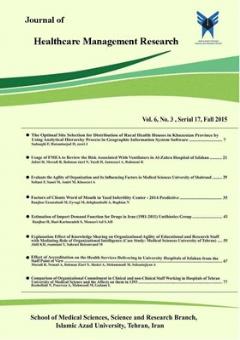Analyzing the Causes and Consequences of Occupational Burnout among Nurses Based on a Field Study
Subject Areas : Health information management
1 - Department of Clinical Psychology, SR.C, Islamic Azad University, Tehran, Iran
Keywords: Occupational Burnout, Nurse, Hospital, Medical Centers, Medical Strategies, Contextual Research.,
Abstract :
Introduction: One of the important medical and health professions faced with occupational burnout phenomenon is nursing. Monitoring the developments, attitudes, causes, contexts, interventions, and consequences of this phenomenon among nurses can pave the way for human resource policies in health centers to control its harms.
Method: From the perspective of nurses working in Tehran, the present research investigated the causes and consequences of occupational burnout and its control strategies using contextual research method. Sampling was done using a theoretical method, and the number of interviewees (sample size) was based on theoretical saturation, 45 nurses from the medical staff in Tehran. After conducting a semi-structured interview, the data were analyzed using the Strauss and Corbin systematic method.
Findings: 144 primary codes, 34 subcategories, 13 main categories, and one core category were extracted from the data coding, and a paradigmatic model was formed in the form of causal, intervening, contextual, strategical, and consequential conditions. The findings indicated that the phenomenon of nurses' occupational burnout originates from the causes of occupational conflict and occupational and organizational causes and, in the context of interaction and social intervention, human resource pressure and social pressure, it leads to negative individual, domestic, social, and occupational consequences and degrading the quality of their professional, personal, and family life.
Conclusion: To reduce nurses' occupational burnout, it is necessary to utilize individual strategies (personal adjustment, counseling, and psychoanalysis), family strategies (domestic support), and organizational strategies (reducing work-family conflict, reforming the organizational structure, involving nurses in policymaking and respecting and encouraging them, reforming organizational interactions, strengthening human resources, and reforming social interactions between nurses and the community).
[1] Rouzban, R.; & Saki, R. 2012. Investigating the Relationship between Teachers’ Occupational Burnout, Organizational Commitment and Job Motivation among Elementary School Teachers in the Public Schools in Nazar Abad city, Iran, in the academic year 2011-2012. Master's thesis, Faculty of Humanities and Physical Education, Shahid Rajaei Teacher Training University.
[2] Heydari, A.; & Rastgoo, F. 2024. Reasons for Nurses' Migration: A Narrative Review of Health Research and Development, 2 (3): 13-23.
[3] Freudenberger, H. J. 1975. The Staffʼs Occupational Burnout Syndrome in Alternative Institutions. Psychotherapy: Theory, Research & Practice, 12(1), 73.
[4] Bordbarian, F.; Mahzabi, M.; & Jafari, S. M. B. 2015. Assessment of Occupational Burnout and Identifying Its Factors in Shiraz Regional Electricity Company. Fourth National Conference and Second International Conference on Accounting and Management.
[5] Guo, J., Chen, J., Fu, J., Ge, X., Chen, M., & Liu, Y. 2016. Structural Empowerment, Job Stress and Occupational Burnout among Nurses in China. Applied Nursing Research, 31, 41-45.
[6] Samadi-Miarkalaei, H.; Hosseini, S. Z.; & Samadi-Miarkalai, H. 2017. Analyzing the Effects of Job Security on Nurses' Occupational Burnout Syndrome. Quarterly Journal of Nursing Management, 5(3): 71-79.
[7] Janeway, D. (2020). The role of psychiatry in treating burnout among nurses during the Covid-19 pandemic. Journal of radiology nursing, 39(3), 176-178.
[8] Shams, H.; & Mousavi, S. A. 2012. Investigating a Role’s stressful Factors, Occupational Burnout, and Job Enrichment on Improving Employeesʼ Performances (A Case study: Saderat Bank Branches in Shiraz, Iran) Master's thesis, Faculty of Humanities, Payam Noor University, Fars Province, Iran.
[9] Ross, J. 2020. The Exacerbation of Occupational Burnout during COVID-19: A Major Concern for Nurses Safety. Journal of Perianesthesia Nursing, 35(4), 439-440.
[10] Habibi, E.; Dadkhah Tehrani, S.; Gharebaei, S.; & Mahaki, B. 2015. Investigating the Relationship between Shift Work and Occupational Burnout among Nurses at Al-Zahra Hospital Using Maslach Burnout Questionnaire. Health System Research, 11(1), 641-650.
[11] Farsi, Z.; Rajaee, N.; & Habibi, H. 2014. Investigating the relationship between Occupational Burnout and the Quality of Work Life among Nurses Working in IRI Army’s Affiliated Hospitals in Tehran. Military Caring Sciences, 1(2 (Issue 2), 63-72.
[12] Rangriz, H.; Mousavi, S. Z. 2014. The Effects of Occupational Burnout due to Workload and Shortage of Nurses in Iranian hospitals Considering the General Health Policies. Strategic and Macro Policies, 2(7), 43-64.
[13] Abdi Masooleh, F.; Kaviani, H.; Khaghanizadeh, M.; & Momeni Eraghi, A. 2007. Investigating the Relationship between Occupational Burnout and Mental Health: A Study among 200 Nurses. Journal of the Faculty of Medicine, 65(6), 65-75.
[14] Hakim Shushtari, M.; Khajeh al-Din, N.; Arabgol, F.; & Elahi, F. 2004. The Relationship between Occupational Burnout Syndrome among Nursing Mothers and Behavioral Problems among Their Children. Cognitive Science Updates, 6 (1-2 (Issue 22)), 67-72.
[15] Strauss, A.; & Corbin, J. 2016. Fundamentals of Qualitative Research: Techniques and Steps for Generating Grounded Theory. Persian Translation by Ebrahim Afshar, Ney Pub., Tehran.
[16] Strauss, A., & Corbin, J.1994. Grounded Theory Methodology: An Overview. In N. Denzinin, & Y. Lincoln (Eds), Handbook of Qualitative Research. Thousand oaks, CA: Sage.
[17] Goulding, C. 2002. Grounded Theory: A Practical Guide for Management, Business& Market Researchers, London: Sage Publications.
[18] 18. Maslach C, Jackson SE. 2001. The Measurement of Experienced Burnout. Journal of occupational behavior. 2(2):99-113.
[19] 19. Hultman, C. S., & Neumeister, M. W. 2017. Wellness and Burnout in Burn Care Providers: Professionalism, the Social Covenant, and the 7 Habits of Highly Effective Teams. Clinics in Plastic Surgery, 44(4), 943-948.
[20] 20. Schwarzkopf, K., Straus, D., Porschke, H., Znoj, H., Conrad, N., Schmidt-Trucksäss, A., & von Känel, R. 2016. Empirical Evidence for a Relationship between Narcissistic Personality Traits and Occupational Burnout. Burnout Research, 3(2), 25-33.
[21] 21. Liu, J., Wang, W., Hu, Q., Wang, P., Lei, L., & Jiang, S. 2021. The Relationship between Phubbing and the Depression in Primary and Secondary School Teachers: A Moderated Mediation Model of Rumination and Occupational Burnout. Journal of Affective Disorders, 295, 498-504.

